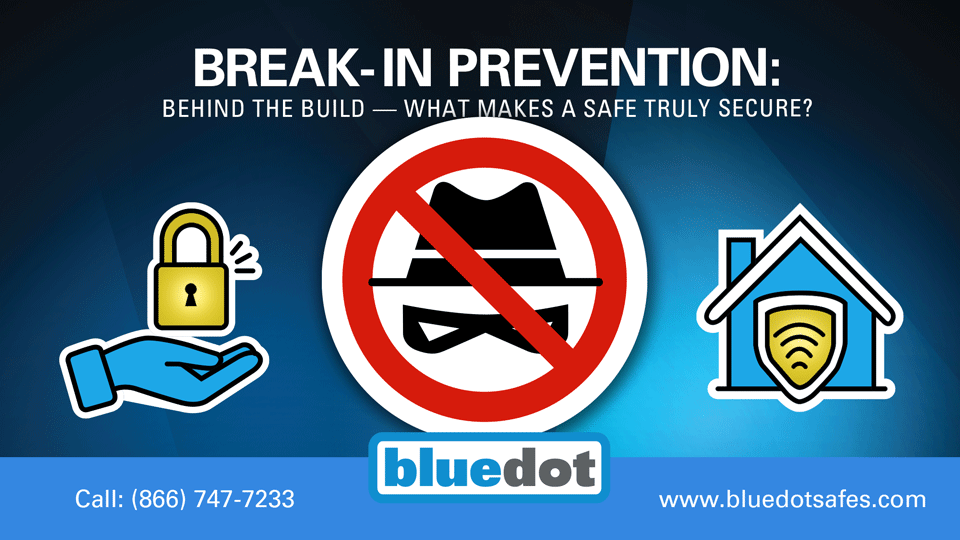
How to Protect Your Store from Break-Ins with the Right Safe Build
How to Protect Your Store from Break-Ins with the Right Safe Build

🔐 Break-in Prevention: Behind the Build — What Makes a Safe Truly Secure?
In today’s world of increasingly sophisticated break-ins, simply owning a safe is no longer enough. The real question is not just “Do you have a safe?” — but “Is your safe truly built to protect you when it matters most?”. A secure safe isn’t just a locked metal box. It’s the result of thoughtful engineering, combining strong materials, smart design, and tested technologies that resist forced entry. Let’s take a closer look at the critical features that determine whether a safe can genuinely stand up to a break-in attempt.
🧱 1. Steel Construction & Barrier Material
- Steel thickness plays a central role. The thicker the steel (lower gauge), the harder it is to cut, grind, or pry.
- Many high-security safes use composite layering — combining outer and inner steel shells with fireboard or concrete fill — to add time and resistance against both burglary and fire.
- Safes with tool-resistance ratings like TL‑15 or TL‑30 have been tested to withstand prolonged attacks using drills, saws, and torches.
🔥 2. Fire & Heat Protection
- A strong safe must also protect against environmental threats like fire.
- Fire-rated safes are often tested to withstand internal temperatures of over 1,200°F (649°C) for up to 2 hours.
- Look for features like multi-layered fireboard and intumescent door seals, which expand under heat to block out flames and smoke.
- Third-party fire ratings (such as UL or ETL) offer assurance that the safe meets minimum fire-protection standards.
🛠️ 3. Locking Mechanisms & Access Control
- Lock type is critical — common options include:
- Electronic keypads with PIN access,
- Mechanical dials, and
- Biometric scanners (e.g. fingerprint locks).
- Look for safes that include:
- Time-delay features, to slow down theft during high-pressure situations.
- Audit trail capability, which records each access attempt with time and user code — useful in business or multi-user environments.
- Dual-access options, requiring two individuals (or a manager override) for high-security scenarios.
🧩 4. Structural Defense Against Physical Attacks
- Advanced burglary protection involves the safe’s design and hardware:
- Anti-pry doors are built with recessed edges and multi-bolt systems to resist crowbar entry.
- Reinforced or internal hinges reduce external attack points.
- Drill-resistant hard plates protect the locking mechanism by shattering drill bits or deflecting force.
- Some safes also include relockers — devices that activate when tampering is detected, permanently locking the safe until professionally reset.
🛡️ 5. Certifications & Testing
- A safe is only as trustworthy as its testing.
- Common burglary ratings include:
- UL RSC: Resists basic burglary tools for 5 minutes.
- TL‑15 / TL‑30: Resists advanced tools for 15 or 30 minutes respectively.
- These tests are performed by independent organizations and confirm a safe’s ability to resist real-world break-in techniques.
- For firearm safes, additional standards such as DOJ approval ensure compliance for legal gun storage
📍 6. Safe Placement: The Overlooked Security Layer
Even the most secure safe can be compromised if it’s placed in a vulnerable or highly visible location. Proper placement plays a vital role in maximizing a safe’s overall security.
- Position safes in low-visibility areas, such as closets, utility rooms, or concealed furniture enclosures.
- Use anchor bolts to secure the safe to a concrete floor or load-bearing wall, making physical removal nearly impossible.
- Avoid common target zones like master bedrooms and home offices, which are often the first areas intruders search.
- In business environments, balance user accessibility with controlled visibility to prevent unauthorized observation or access.
True break-in prevention starts with build quality. A truly secure safe incorporates strong steel, fire-tested materials, tamper-resistant mechanisms, and verified certifications — all working together to protect what matters most.When evaluating any safe, look beyond surface features. Understand what’s beneath — because in the event of a fire or break-in, it’s the internal structure and engineering that makes the difference.
💡 Why Smart Retailers Trust Blue Dot Safes
In retail, security isn’t just about locking things up — it’s about controlling access, reducing internal losses, and building trust within your team. That’s why many businesses turn to Blue Dot Safes, whose solutions are designed to meet the real-world challenges of modern retail environments.
Here’s how Blue Dot Safes help retailers secure operations and safeguard profits:
✅ Comprehensive Safe Solutions – From gun safes to high security, deposit, utility, and floor safes, Blue Dot offers secure storage for every retail need.
✅ Advanced Access Control – Features like multi-user keypads, audit trails, time-delay locking, and manager overrides provide layered security and accountability.
✅ Proven Physical Protection – Engineered with anti-pry doors, drill-resistant plates, relockers, and certified to UL TL-15/TL-30 and DOJ standards for real-world burglary resistance.
✅ Expert Setup & Ongoing Support – Blue Dot’s team offers professional guidance during setup and training, ensuring your system is configured for maximum effectiveness.
🇺🇸 Proudly made in the U.S., Blue Dot Safes is trusted by retailers nationwide, Blue Dot Safes combine steel protection with intelligent features that enhance accountability, reduce shrink, and support daily operations.
💬 Ready for a Custom Recommendation?
📞 Call us at (866) 747-7233
📧 Email: [email protected]
🌐 Explore solutions at bluedotsafes.com






